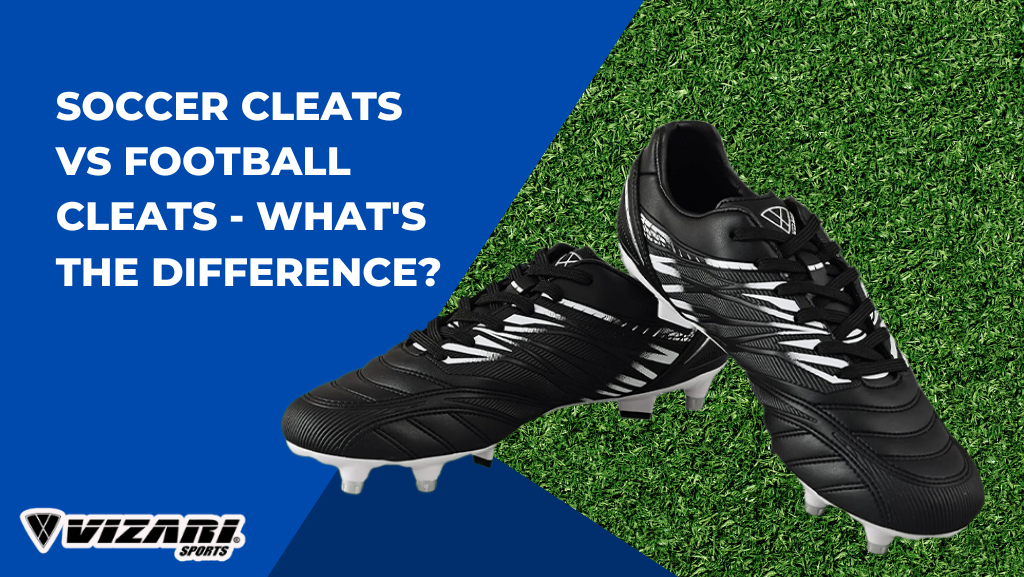
Soccer Cleats vs Football Cleats - What's the difference?

Introduction
The difference may not seem like a lot, but it indeed shows when competing in soccer or football on the gridiron. Soccer cleats and football cleats may appear similar, but you will soon understand that each category has a different application for the sports. This guide will help you understand your differences when comparing soccer cleats with football cleats so you can select which to use when playing your game.
What Are Cleats? A Quick Overview
The Role of Cleats in Sports
Cleats are the most important parts of the shoes that allow athletes to have traction, agility, and safety. Although both soccer and football require stability and quick movements, both of these sports make different demands on the design of cleats. Soccer cleats should offer support for speed, agility, and ball control, and football cleats should offer protection, durability, and stability for high-impact situations.
Are All Cleats Created Equal?
No, cleats do not come in one-size-fits-all. Soccer cleats, football cleats, soccer cleats, and cleats for each sport are uniquely designed to meet the needs and demands of each sport and its players. Using improper cleats can lead a player to a poor game or even an injury. Often, soccer cleats allow for speed and agility but are lighter and more streamline, while football cleats would be bulkier with added protection over tackling and impact.
Soccer Cleats vs. Football Cleats: The Core Differences
Design and Material
- Soccer Cleats: Soccer cleats are designed with an emphasis on agility, speed, and ball control. By default, they'll be made from synthetic or leather material to provide flexibility along with a snug fit-the player gets a better touch at the ball.
- Football Cleats: Football cleats are made heavier with added padding and thicker soles for maximum protection and durability. They are made of materials that can be used in situations and harsh conditions on the field.
Studs and Soles
- Soccer Cleats: The studs of soccer cleats are relatively shorter and arranged in a fashion to enable quick pivoting around on smooth grass or turf surfaces. Thus, they provide quick acceleration and even accurate changes of direction.
- Football Cleats: In contrast, football cleats are longer and more aggressive in studs. They are used to dig into the turf for stability in tackles and for fast directional changes. During intense playing, players can maintain a firm grip on the turf.
Ankle Support
- Soccer Cleats: These cleats are usually low-cut, which contributes to maximum movement freedom and agility. They are meant for speed footwork and accurate ball control while preventing the ankle's snagging.
- Football Cleats: Football cleats come in a variety of cuts—high-top, mid-cut, and low-cut. High-top cleats provide added ankle support for positions that require frequent tackling or sudden stops, while mid-cut and low-cut designs cater to players seeking a balance between mobility and protection.
Why Soccer Cleats Lack Toe Studs
Soccer cleats do not have toe studs because it is more important to be safe when kicking. A toe stud can be dangerous for the player and the opponent who will be hit by the foot when striking the ball. It maximizes traction but does not offer a chance of a toe injury.
Selecting the Right Cleats for Your Sport
Can Soccer Cleats Be Worn for Football?
While soccer cleats can be worn for football, it would hardly be a shoe of choice for the activity. Football demands toughness and shock absorption rather than the speed and agility required in soccer cleats. There is a better chance that discomfort, instability, or even an injury could occur with such plays as one is likely to go for soccer cleats.
Can Football Cleats Be Used for Soccer?
Football cleats are not a good fit for soccer as they will increase weight and bulk and compromise quick movements and ball control. Longer studs on football cleats will also create issues with smooth soccer fields, thereby resulting in a loss of grip and agility.
How to Choose What to Buy
When selecting cleats, consider your position, playing surface, and the specific needs of your sport. Soccer players need cleats that offer lightweight speed and agility, while football players need cleats that offer durability and protection for tackling and sudden movements. Make sure to evaluate the type of surface you’ll be playing on (grass, turf, etc.) to choose the best stud configuration.
Top Mistakes When Buying Cleats
Common errors of cleats purchases
- Wrong size. This can cause discomfort and decrease performance.
- The use of cleats for one sport in another can lower the performance and ease with which one executes actions in a game.
- Some focus only on appearance, which is a disaster because function and comfort are ignored.
FAQs
Q. Are soccer cleats lighter than football cleats?
A: Yes, soccer cleats tend to be lighter than football cleats. They are built for agility and speed, while football cleats are way more bulky, which makes them heavier to provide added protection and stability for big plays.
Q. What's the Price Difference Between Soccer and Football Cleats?
A: Though there are many price disparities, football cleats tend to be more expensive than soccer cleats due to their better durability, protection features, and heavier design. Additionally, high-end models with excess padding, studs, and materials make football cleats even pricey compared to soccer cleats.
Conclusion
The key difference between soccer cleats and football cleats can help one get the best out of his performance as well as ensure he does not end up injured unnecessarily. He will thus end up having improved on-field performance, avoid injuries, and a more comfortable game. Make sure to invest in the right gear for your needs and take your game to a whole new level!

